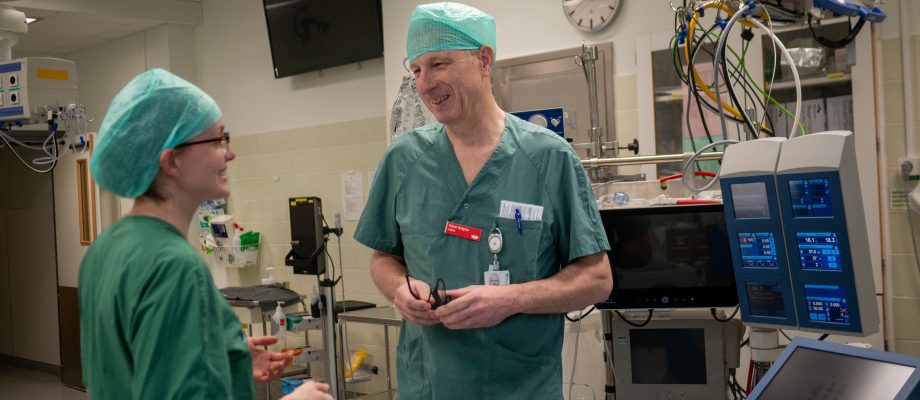NEW STUDY. After ten years of research, it is now clear which medication is most effective in preventing both acute and chronic rejection after lung transplantation. The treatment algorithm throughout Scandinavia has been changed thanks to a multinational study led by Göran Dellgren at the University of Gothenburg. The study was recently published in The Lancet Respiratory Medicine.
The study, named ScanCLAD, compared the effectiveness of the two traditionally used medications: tacrolimus and cyclosporine. The results were fully analyzed in the spring and have already changed the treatment of lung transplant recipients in Scandinavia and at many transplant centers worldwide.
The study was led by Göran Dellgren, university physician in thoracic and transplantation surgery at Sahlgrenska University Hospital and newly appointed professor at the Department of Clinical Sciences:

“In Sweden and the other Scandinavian countries, cyclosporine was the ‘to-go-to’ medicine to treat lung transplant recipients. However, there was insufficient scientific evidence to determine if that was the more effective medication. When we began our research, we did not have any preconceived notions.”
Five hospitals from Sweden, Norway, Finland, and Denmark collaborated on the study. Around 250 patients from these countries were randomly assigned to two equivalent groups. During three years after their lung transplantation, one group received a daily dose of tacrolimus, while the other group received two doses of cyclosporine.
A unique breakthrough
The results indicate that in the group that received cyclosporine, chronic lung rejection (CLAD, chronic lung allograft dysfunction) occurred in 40 percent of patients, whereas in the group that received tacrolimus, it was only 14 percent. Dellgren’s study shows that three years after transplantation, tacrolimus is significantly more effective than cyclosporine in preventing CLAD.
The study has changed the treatment algorithm throughout Scandinavia. Another positive aspect is that patients that undergo a lung transplantation are now treated and monitored in the same way in the Nordic countries.
“Previously, patients were treated differently in the countries involved in the study. But we needed to work consistently to ensure the reliability of the study.”
Positive reception
ScanCLAD was acclaimed earlier this fall when it was published in The Lancet Respiratory Medicine, the world’s leading journal for respiratory medicine and intensive care.
![]() Why do you think the study has received such a positive reception?
Why do you think the study has received such a positive reception?
“No previous study on the subject has been conducted in such a controlled and reliable manner as we have, with randomization, independent reviewers, and the right number of patients. There have also been no previous comparisons between these two medications with the dosages we used. Additionally, the study showed clear differences in recovery between patients who received tacrolimus and those who received cyclosporine.”

Opening the door for further research
ScanCLAD will generate several side studies. For example, patients initially given cyclosporine have now been offered to switch to tacrolimus.
“It’s not certain that everyone will want to switch to tacrolimus. There is no evidence that changing medications after three to four years would yield positive results. We will follow the development, and hopefully, it will give us an indication of whether a change would be beneficial or not.”
The study has also strengthened cooperation between the Scandinavian countries. Researchers are now discussing other projects with new, more modern medications for this patient group.
Every penny counts
In addition to lung transplantation, Göran Dellgren researches the treatment of heart failure with either medication or a pump. For this, he received a significant grant from the Heart-Lung Foundation in 2017.
“I do research on the thoracic organs and their transplantations. I have many ideas, but it’s expensive to implement them. Most studies are financed mainly thanks to sponsors and private donors. Every penny counts, from wealthy individuals donating thousands per month to single parents donating 15 kronor on occasion.”
![]() What does ScanCLAD mean for patients and the medical world – and for yourself?
What does ScanCLAD mean for patients and the medical world – and for yourself?
“The study means that more patients will hopefully survive longer and with a better quality of life after their lung transplant. It has also put us and Scandinavia on the map. Each of the participating hospitals is individually too small to conduct such a complex and extensive study as the one we have now done. But together, we become strong due to greater access to resources, patients, and expertise,” says Göran Dellgren and continues:
“For me personally, the findings of the study mean prestige and recognition, of course, but that is not what drives me in my work. My motivation is to find solutions that can save lives. What we do is a matter of life and death.”
Local Principal Investigators of the ScanCLAD study:
- Consultant Jesper Magnusson, Sahlgrenska Universitetssjukhuset, Göteborg
- Consultant Inga Leuckfeld, Oslo University Hospital, Oslo, Norway
- Consultant Thomas Kromann Lund, Copenhagen University Hospital, Copenhagen, Denmark
- Consultant Peter Raivio, Helsinki University Hospital, Helsinki, Finland
- Consultant Johan Svahn, Skånes Universitetssjukhus i Lund, Sverige
TEXT: ANNA TERESA GARCIA CRUZATA
PHOTO: JAKOB LUNDBERG











